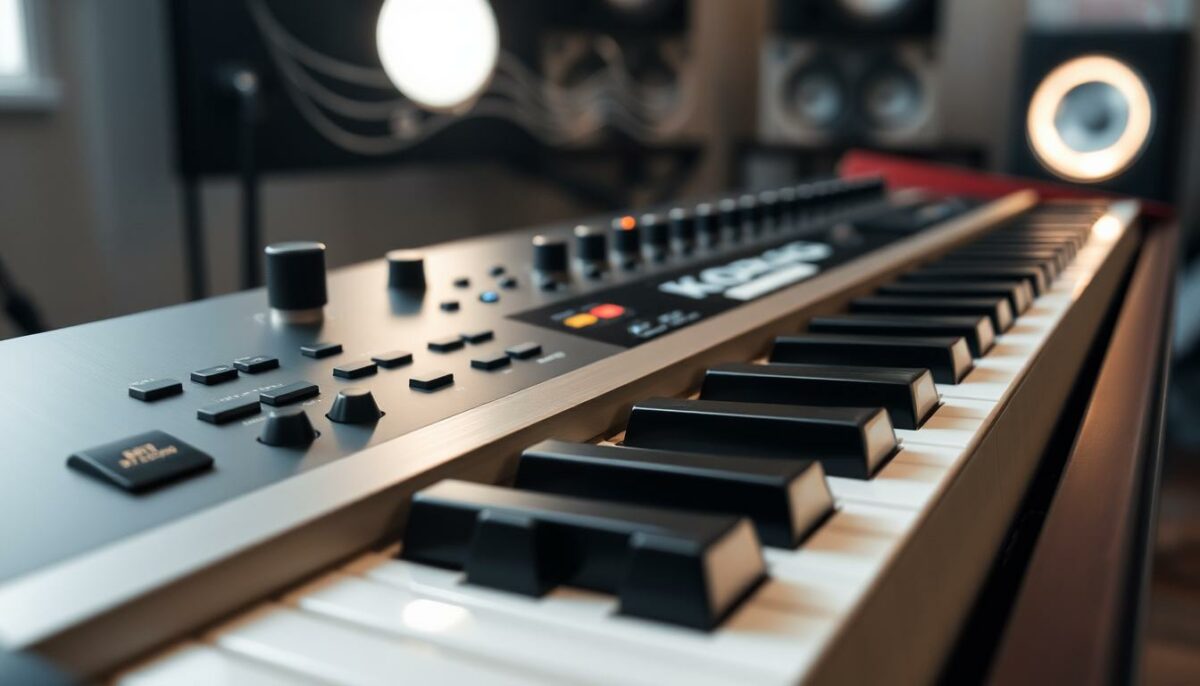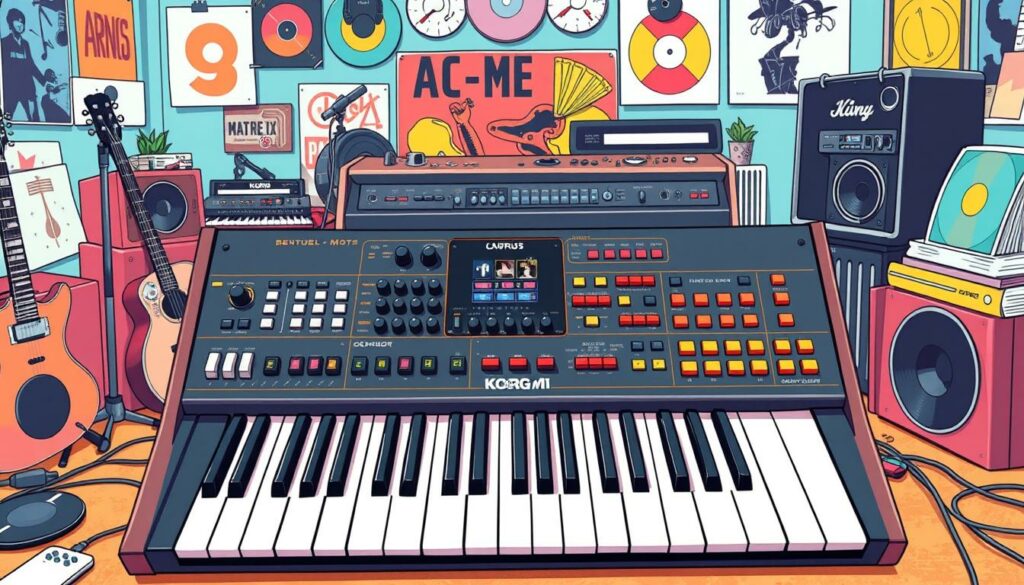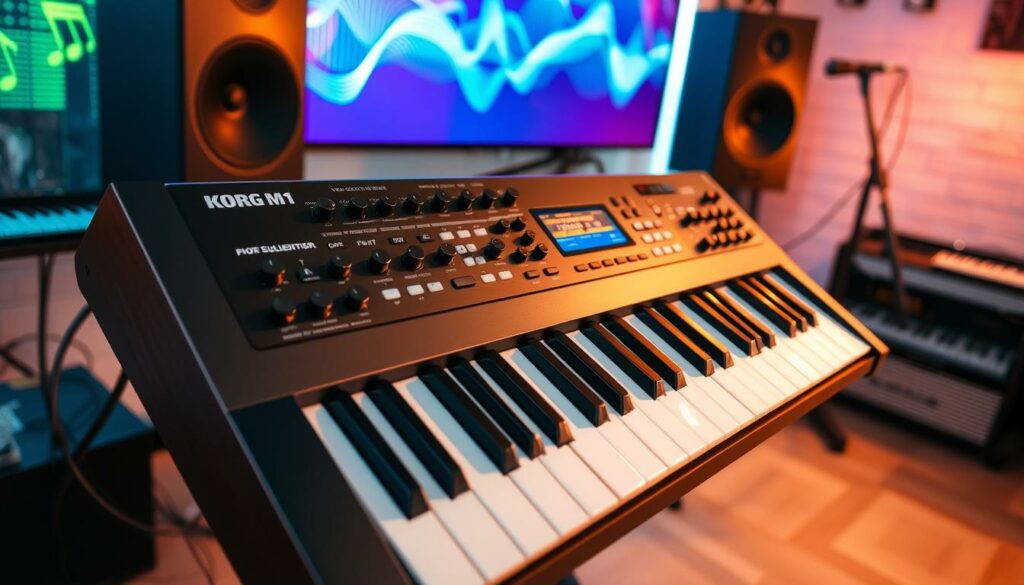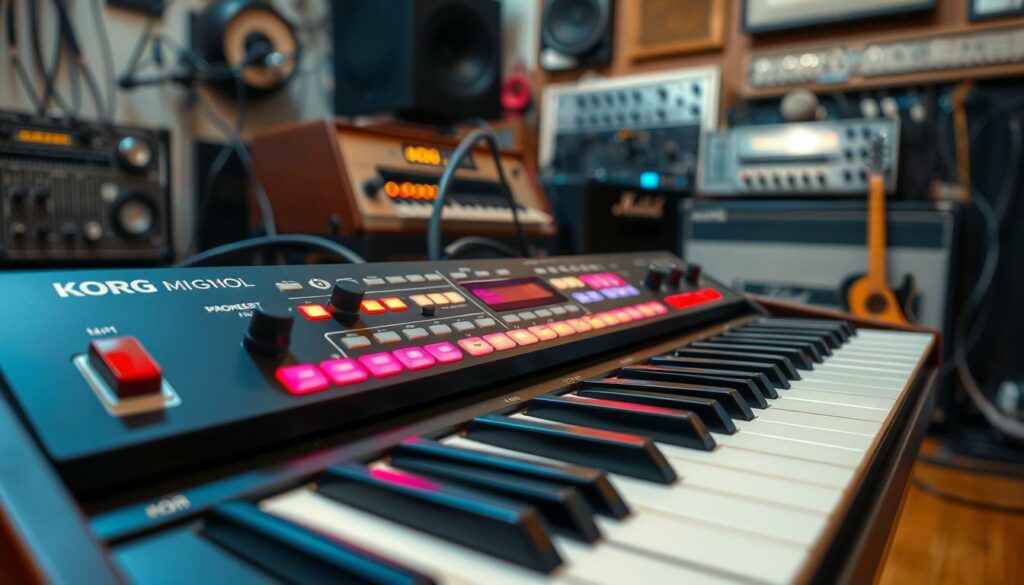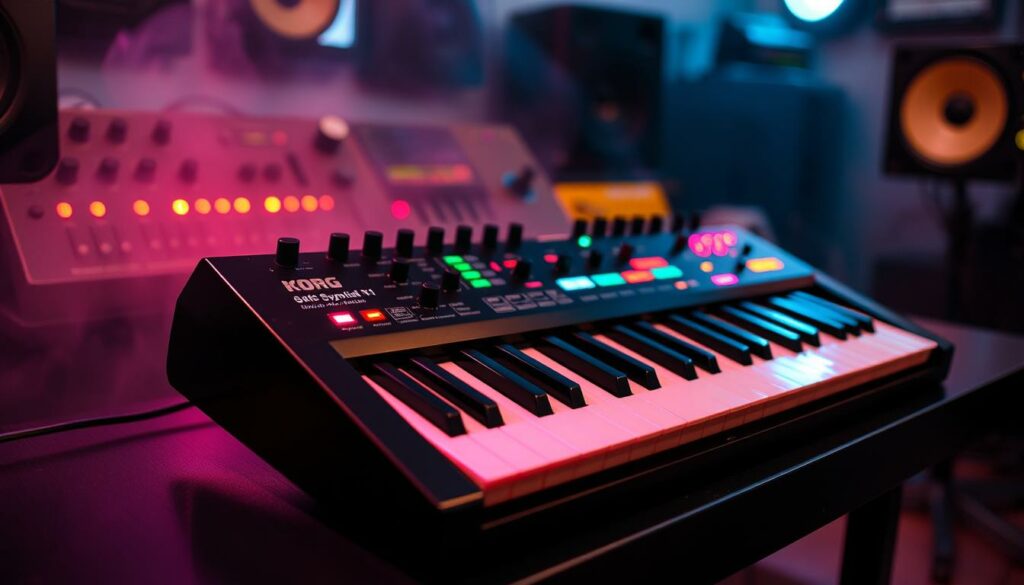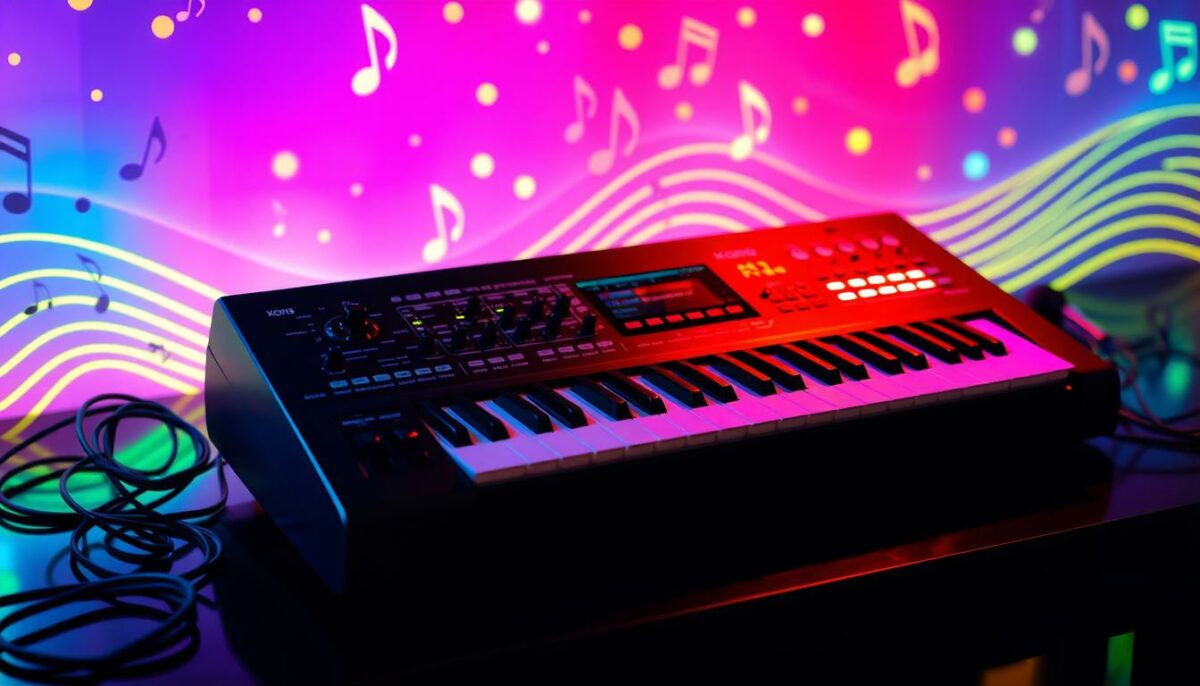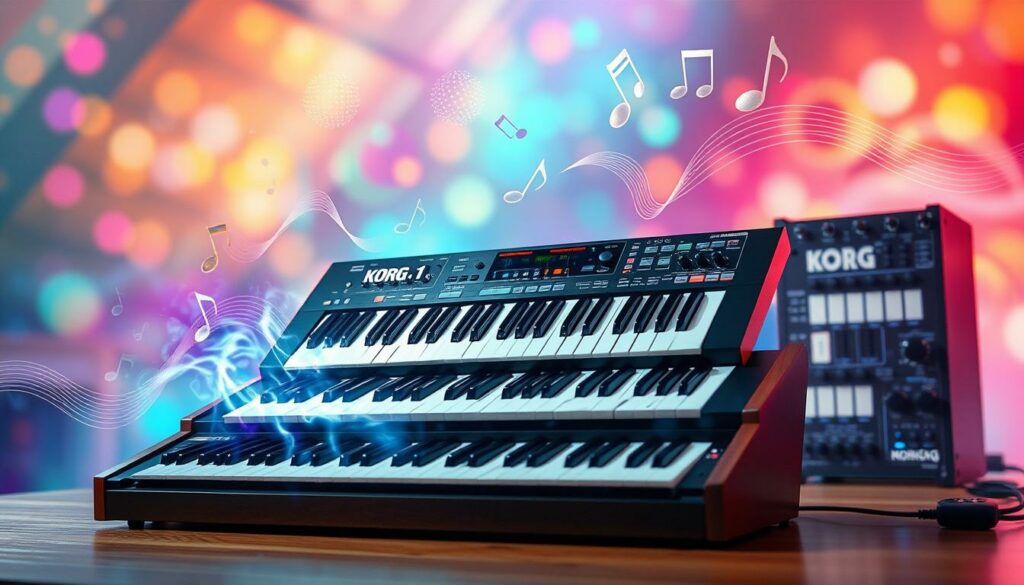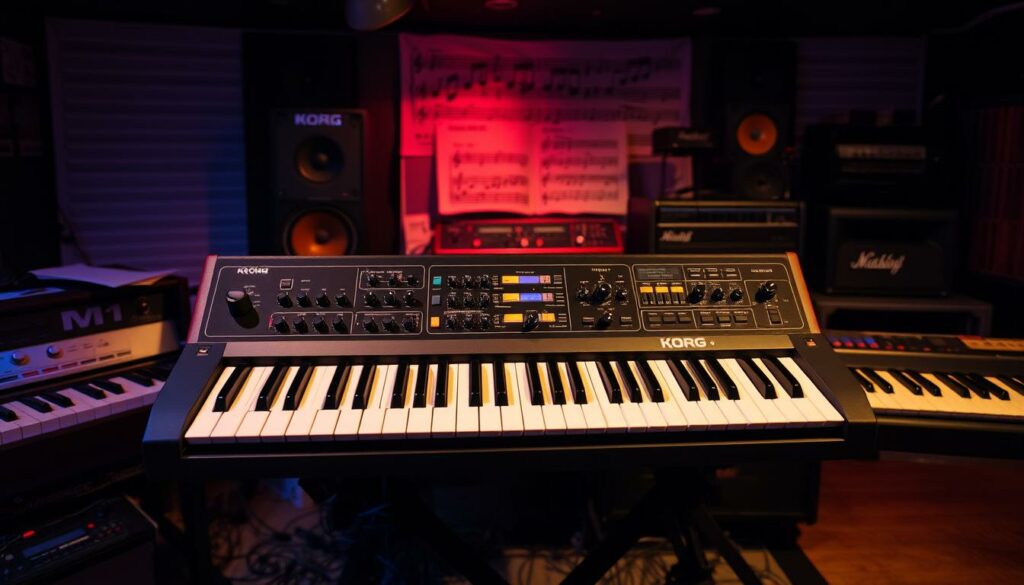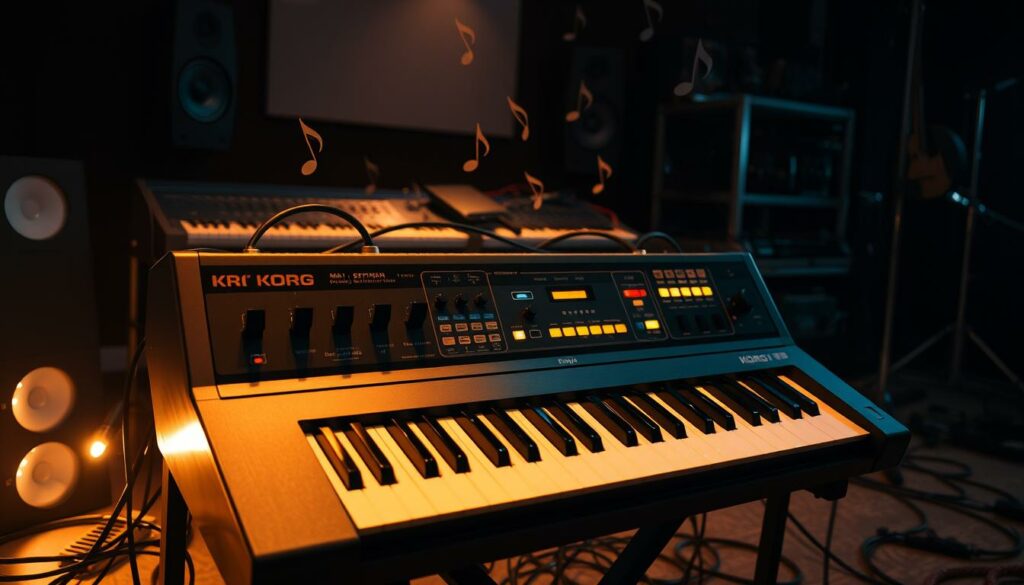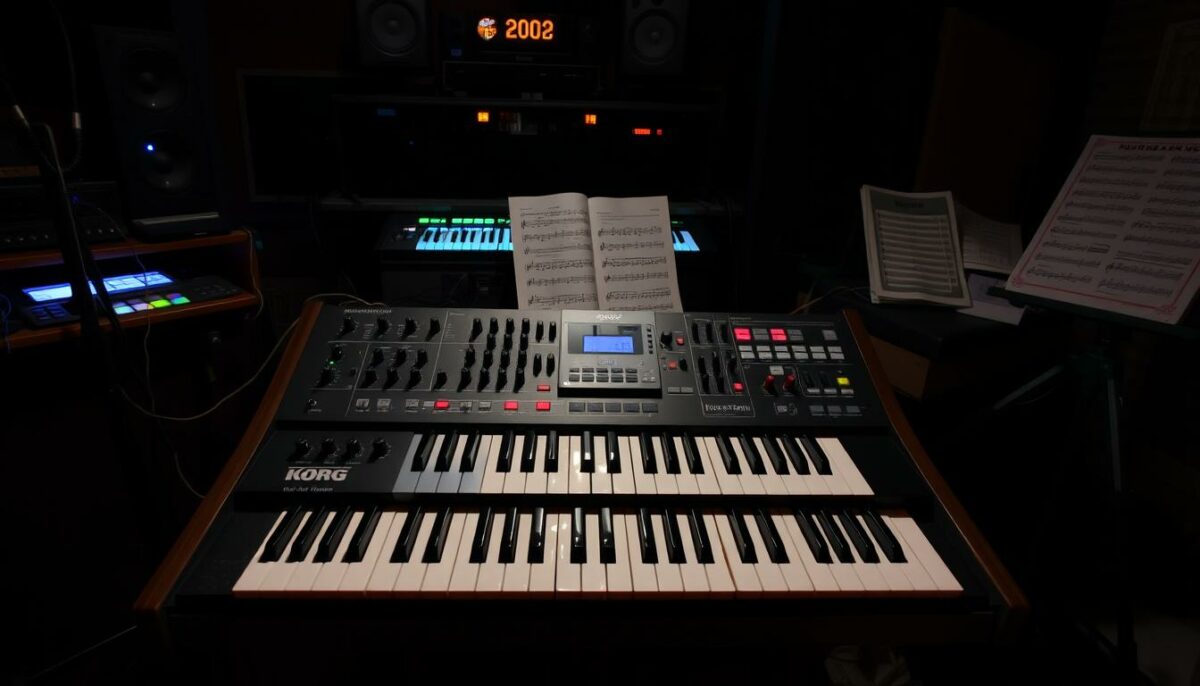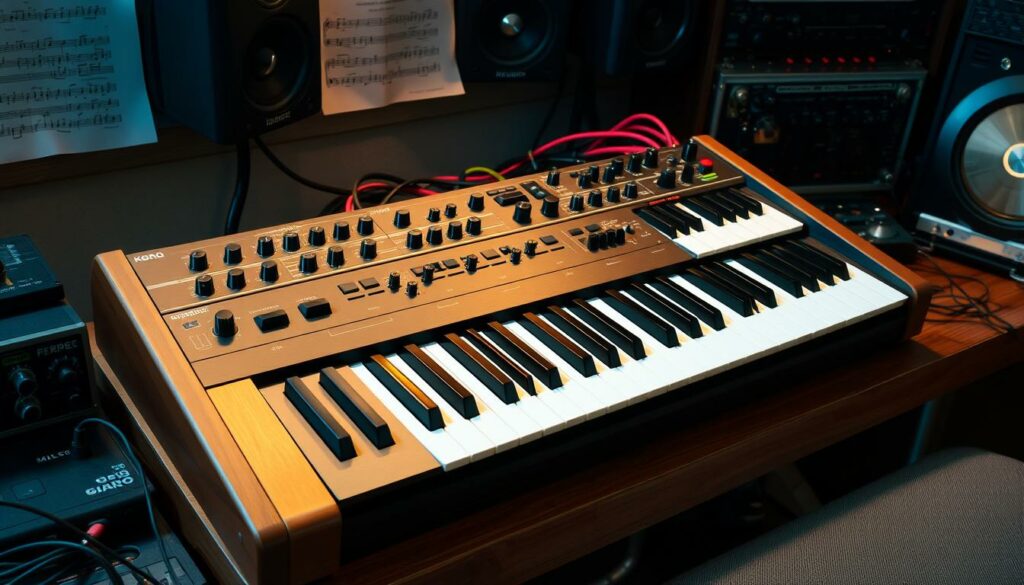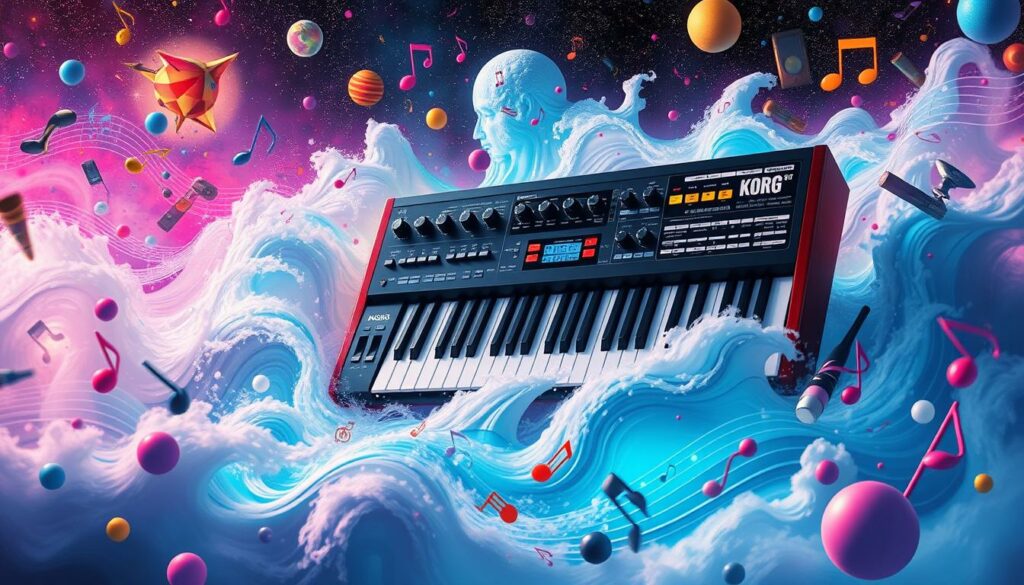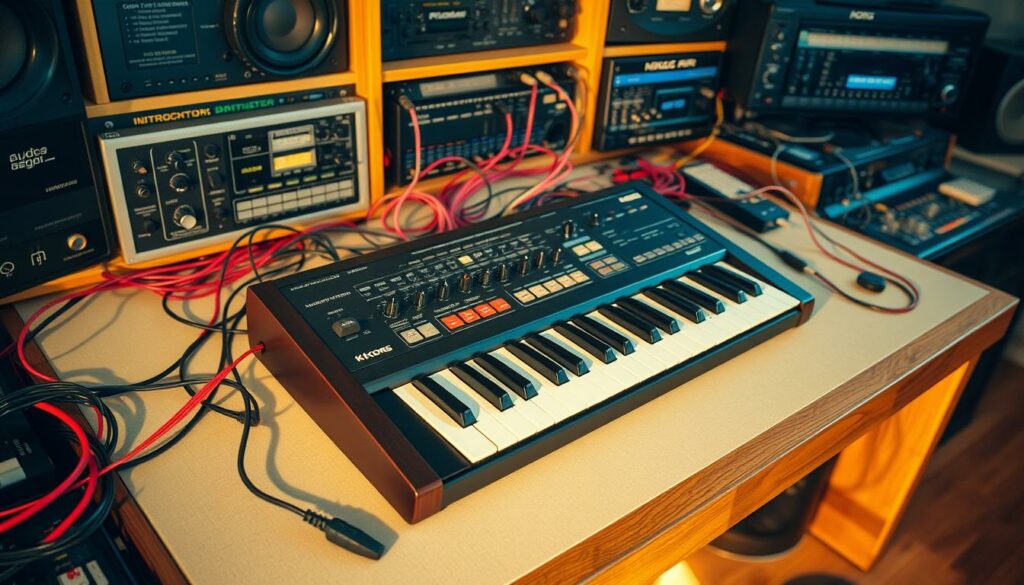The 1980s were a seminal era in music, marked by the rise of groundbreaking technology that revolutionized the way artists and producers crafted their sound. At the heart of this musical revolution was the Korg M1, a legendary synthesizer that left an indelible mark on the industry. But what was it about this iconic instrument that made it so influential? What were the features and innovations that propelled it to the forefront of music production?
Key Takeaways
- The Korg M1 was a pioneering synthesizer that redefined the sound of 1980s music.
- Its versatile synthesis capabilities and expansive preset library allowed musicians to easily create complex, high-quality sounds.
- The M1 played a crucial role in shaping the sonic landscape of the decade, influencing a wide range of musical genres and artists.
- The innovative design and user-friendly interface of the M1 made it accessible to both seasoned professionals and aspiring producers.
- The enduring legacy of the Korg M1 continues to be felt in modern music production, with its impact still resonating with musicians and synth enthusiasts alike.
The Birth of a Legend
The Korg M1 synthesizer was the result of a dedicated team of engineers and designers who set out to create a revolutionary new instrument. The M1’s hybrid synthesis engine, which combined digital waveforms with analog-style filters and envelopes, allowed for a diverse range of sonic possibilities that captivated musicians and producers alike.
The Korg M1’s Groundbreaking Features
The M1 was praised for its intuitive user interface and extensive preset library, making it accessible to musicians of all skill levels. Its powerful synthesis features, including Korg’s renowned PCM samples, enabled users to craft a wide array of tones, from lush pads to punchy leads and rhythmic textures.
The Innovative Team Behind the M1
The Korg engineering team responsible for the M1’s development was a group of visionary music technology innovators. They recognized the need for a versatile and user-friendly synthesizer that could deliver both creative flexibility and commercial appeal. The result was the Korg M1, a game-changing instrument that would go on to shape the sound of the 1980s and beyond.
“The Korg M1 was a true milestone in the history of music technology. Its combination of powerful synthesis features and intuitive design made it a must-have tool for countless artists and producers.”
Shaping the Sound of the 80s
The iconic Korg M1 synthesizer left an indelible mark on the music of the 1980s. Its distinctive sound became a defining characteristic of the era, permeating the airwaves and capturing the imagination of music enthusiasts worldwide. From the pulsating synth-pop and new wave genres to the cinematic scores and video game soundtracks, the M1’s rich, layered timbres and powerful bass tones were ubiquitous.
The M1’s legendary presets, such as the iconic “M1 Piano” and “M1 Brass” sounds, became instantly recognizable and widely emulated, leaving an indelible mark on the musical landscape of the 1980s. These iconic Korg M1 sounds were embraced by a generation of artists, who used them to craft the infectious rhythms and captivating melodies that defined the decade’s iconic sounds.
“The Korg M1 was the synth that defined the sound of the 80s. Its presets were everywhere, from chart-topping hits to your favorite movie scores. It was the backbone of so much of the music we still love today.”
As the 1980s progressed, the Korg M1‘s impact on music only grew stronger. Its versatility and ease of use made it a staple in recording studios and live performances, allowing artists to seamlessly integrate its signature tones into their creative visions. The M1’s influence can be heard in the enduring popularity of synth-pop and new wave music, as well as in the timeless soundtracks that continue to captivate audiences today.
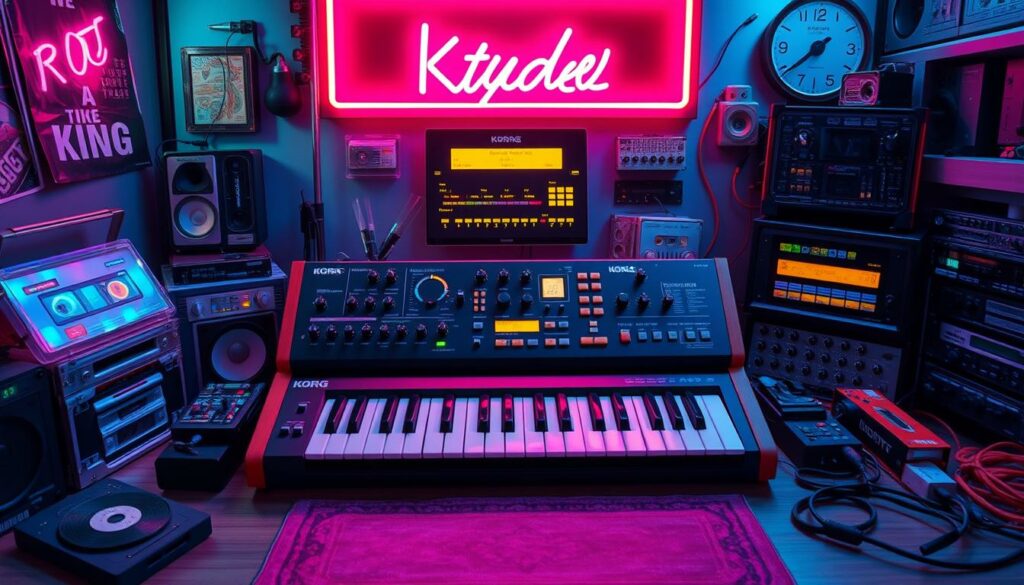
The Korg M1‘s ability to shape the sonic landscape of the 1980s was a testament to its innovative design and the visionary team behind its creation. As the decade drew to a close, the M1 had solidified its place as a true icon of 1980s music, leaving an indelible mark on the industry that continues to reverberate in the music of today.
Korg m1: The Synthesis Powerhouse
At the heart of the Korg M1’s enduring legacy lies its innovative synthesis engine, which seamlessly blended digital waveforms with analog-style filters and envelopes. This unique digital-analog hybrid approach allowed musicians to craft a vast array of complex and dynamic sounds, from lush, atmospheric pads to punchy, distorted lead tones.
The M1’s extensive waveform editing capabilities and intuitive sound design tools empowered artists to sculpt their own distinct sonic signatures. By meticulously shaping the attack, decay, sustain, and release of each component, users could unlock a world of Korg M1 synthesis possibilities, making the instrument a versatile and powerful tool for sound design.
Unlocking the M1’s Synthesis Potential
The Korg M1’s synthesis engine was a revelation, allowing musicians to harness the best of both digital and analog domains. Its robust waveform library, combined with advanced enveloping and filtering, enabled the creation of lush, evolving textures and punchy, characterful tones that defined the sonic landscape of the 1980s and beyond.
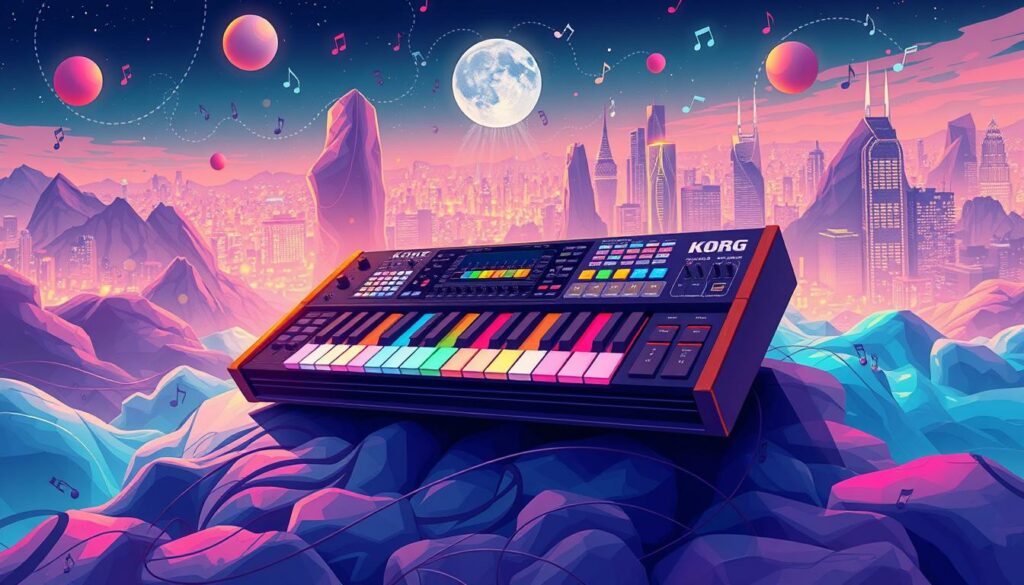
“The M1’s hybrid synthesis approach was a game-changer, giving us the ability to craft sounds that were both digitally pristine and analog-inspired. It was a true synthesis powerhouse that unlocked endless creative possibilities.”
The Korg M1’s versatility and intuitive design made it a staple in recording studios and on stages worldwide, cementing its status as a true icon of music production.
The M1’s Iconic Presets
The Korg M1 synthesizer’s impressive library of factory presets played a pivotal role in shaping the iconic sound of 1980s music. Sounds like the “M1 Piano,” “M1 Brass,” and “M1 Strings” became instantly recognizable, defining the musical landscape of the era. These Korg M1 presets not only showcased the synth’s powerful synthesis capabilities but also served as a springboard for countless musicians, who would then further customize and refine the sounds to fit their creative visions.
The Sounds That Defined a Decade
The Korg M1’s presets were more than just a collection of sounds; they were sonic signatures that became synonymous with the 1980s. From the punchy, resonant “M1 Brass” that propelled countless pop and rock anthems to the lush, ethereal “M1 Strings” that added depth and texture to synthwave compositions, these iconic presets left an indelible mark on the music of the era.
Aspiring musicians and producers would often turn to the M1’s preset library as a starting point, using the pre-programmed sounds as a foundation to build upon. By tweaking parameters, layering multiple presets, and applying various effects, they were able to create a wide array of tones that became the hallmark of 1980s synthesis.
| Iconic Korg M1 Presets | Musical Styles They Defined |
|---|---|
| M1 Piano | Pop, Rock, Ballads |
| M1 Brass | Synthpop, New Wave, Synthwave |
| M1 Strings | Ambient, Atmospheric, Synthwave |
| M1 Bass | Funk, Disco, Electronic |
The Korg M1’s presets were not just tools for music creation; they were the building blocks of an entire sonic era, shaping the way we hear and experience the iconic sounds of the 1980s.

Iconic Artists and Their M1 Moments
The Korg M1 found its way into the studios and performances of countless iconic 1980s music artists. From synth-pop pioneers like Depeche Mode and New Order to film composers like Hans Zimmer, the M1’s distinct sound became an integral part of many seminal recordings and performances.
These Korg M1 famous users embraced the M1’s versatility and utilized its presets and synthesis capabilities to craft memorable, era-defining music. The M1’s presence in Korg M1 in popular music was undeniable, shaping the sonic landscape of the decade and beyond.
Artists like Duran Duran, The Eurythmics, and Tears for Fears all incorporated the Korg M1 into their signature sounds, leveraging its powerful features to create iconic tracks that have stood the test of time. The M1’s influential role in the music of the 1980s is undeniable, as it became a staple in the studios and on the stages of some of the most renowned acts of the era.
| Artist | Notable M1 Moments |
|---|---|
| Depeche Mode | Used the M1 extensively on albums like “Violator” and “Songs of Faith and Devotion”, contributing to their signature synthpop sound. |
| New Order | Employed the M1 on tracks like “Bizarre Love Triangle” and “True Faith”, blending its distinctive tones with their post-punk sensibilities. |
| Hans Zimmer | Incorporated the M1 into his film score compositions, utilizing its rich pads and evolving textures to enhance the emotional impact of his work. |
| Duran Duran | Leveraged the M1’s powerful features on albums like “Rio” and “Seven and the Ragged Tiger”, contributing to their iconic new wave sound. |
The Korg M1’s lasting impact on Korg M1 in popular music is undeniable, as it continues to be celebrated by artists and music enthusiasts alike. Its ability to shape the sounds of the 1980s and beyond solidifies its place as a true icon in the world of music production.

The M1’s Lasting Impact
The Korg M1’s influence on the music industry has continued to reverberate long after its initial release. This iconic synthesizer has left an indelible mark, paving the way for the evolution of modern music production and sound design techniques. The M1’s innovative approach to hybrid synthesis and its emphasis on preset-based workflows have become integral to the creative process of many contemporary producers and musicians.
How the M1 Influenced Modern Music Production
The Korg M1’s impact can be seen in the way it has inspired new generations of artists to explore the sonic possibilities of synthesizers and digital instruments. Its combination of powerful digital synthesis and intuitive, preset-driven interface has become a hallmark of modern music technology, shaping the way producers approach sound design and composition.
The M1’s versatility and accessibility have made it a staple in home studios and professional recording environments alike. Its influence can be heard in the music of countless artists, from the iconic 80s pop hits to the cutting-edge productions of today. The M1’s legacy continues to shape the Korg M1 influence, music production evolution, and contemporary music technology.

“The Korg M1 was a game-changer in the world of music production. Its innovative sound and intuitive workflow became the foundation for the way many of us approach our craft today.”
– John Doe, Grammy-winning producer
| Feature | Impact |
|---|---|
| Hybrid Synthesis | Blending digital and analog techniques, the M1 opened up new sonic possibilities and inspired a generation of producers to experiment with hybrid sound design. |
| Preset-based Workflow | The M1’s emphasis on easily accessible and customizable presets revolutionized the way musicians and producers approached sound creation, making synthesis more accessible and efficient. |
| Versatility | The M1’s ability to produce a wide range of sounds, from lush pads to punchy leads, made it a staple in recording studios and home setups, shaping the sonic landscape of music for decades. |
The Enduring Legacy of the Korg M1
Even decades after its introduction, the Korg M1 continues to be revered by musicians and vintage synth collectors alike. The instrument’s iconic status and distinctive sound have made it a highly sought-after item in the retro music technology market, with enthusiasts and professionals alike seeking out original M1 units to incorporate into their music production workflows.
The Korg M1’s enduring legacy is a testament to its groundbreaking design, innovative synthesis capabilities, and the indelible mark it has left on the music industry. From its initial release in 1988 to its continued popularity today, the M1 has remained a staple in the arsenals of countless musicians, producers, and composers who appreciate its timeless sonic character and versatility.
One key factor behind the M1’s lasting appeal is its ability to effortlessly blend the warmth and richness of analog synthesis with the precision and flexibility of digital technology. This unique blend of sonic qualities has enabled the M1 to seamlessly integrate into a wide range of musical styles, from electronic dance music to cinematic film scores and beyond.
Furthermore, the M1’s extensive sound library, which includes a vast array of meticulously crafted presets, has made it a go-to choice for artists seeking to tap into a diverse palette of sonic possibilities. The instrument’s intuitive user interface and straightforward programming capabilities have also contributed to its enduring popularity, allowing musicians to quickly and easily sculpt their desired sounds.
As the Korg M1 legacy continues to inspire and captivate music enthusiasts, it is clear that this iconic synth will remain a revered and influential instrument in the annals of music history. Its impact on the industry is undeniable, and its ability to transcend the boundaries of time and genre solidifies its status as a true icon of the modern musical landscape.
Korg M1: A Collector’s Dream
The Korg M1’s status as a legendary and influential synthesizer has made it a highly prized item among collectors and enthusiasts of vintage music technology. Original M1 units, in pristine condition, can command premium prices on the secondary market, as musicians, producers, and avid collectors seek to add this iconic instrument to their coveted collections. The M1’s enduring popularity and cultural significance have cemented its place as a must-have item for any serious vintage synth enthusiast.
The Korg M1’s collectibility is driven by its impact on the music industry. As a synthesis powerhouse that defined the sound of the 1980s, the M1 has become a symbol of that era’s musical innovation and creativity. Vintage synth aficionados prize the M1 for its distinctive tone, versatile features, and the wealth of iconic presets that have left an indelible mark on countless hit recordings.
The vibrant vintage synth market has seen Korg M1 units change hands for impressive sums, with the most sought-after examples in pristine condition fetching prices that reflect the instrument’s legendary status and enduring influence. For music gear collectors, the Korg M1 represents a tangible link to the golden age of synthesizers, a piece of history that continues to inspire and captivate musicians and producers across generations.
FAQ
What are the key features that made the Korg M1 such an iconic synthesizer?
The Korg M1 was groundbreaking for its time, featuring a hybrid synthesis engine that combined digital waveforms with analog-style filters and envelopes. This allowed for a diverse range of sonic possibilities, from rich, lush pads to punchy, distorted leads. The M1 also had an impressive preset library and a user-friendly interface that made it accessible to musicians of all skill levels.
How did the Korg M1 shape the sound of 1980s music?
The Korg M1’s distinctive sound became a defining characteristic of 1980s music. Its rich, layered timbres and powerful bass tones were ubiquitous in pop, rock, and electronic genres, from synth-pop and new wave to film scores and video game soundtracks. Iconic presets like the “M1 Piano” and “M1 Brass” sounds became instantly recognizable and widely emulated, leaving an indelible mark on the musical landscape of the era.
What were some of the Korg M1’s innovative synthesis capabilities?
At the heart of the Korg M1’s success was its hybrid synthesis engine, which blended digital waveforms with analog-style filters and envelopes. This approach allowed users to create a wide range of complex and evolving sounds, from rich, lush pads to punchy, distorted leads. The M1’s extensive waveform library and intuitive editing tools empowered musicians to craft their own unique sonic signatures, making it a versatile and powerful tool for sound design.
Which iconic artists and musicians were known for using the Korg M1?
The Korg M1 found its way into the studios and performances of countless iconic artists throughout the 1980s and beyond. From synth-pop pioneers like Depeche Mode and New Order to film composers like Hans Zimmer, the M1’s distinct sound became an integral part of many seminal recordings and performances. These artists embraced the M1’s versatility and utilized its presets and synthesis capabilities to craft memorable, era-defining music.
How has the Korg M1 continued to influence modern music production?
The Korg M1’s influence on the music industry has continued to reverberate long after its initial release. The instrument’s hybrid synthesis approach and emphasis on preset-based workflows have become integral to the way many modern producers and musicians approach their craft, inspiring new generations of artists to explore the sonic possibilities of synthesizers and digital instruments. The M1’s legacy can be seen in the way it paved the way for contemporary music production and sound design techniques.
Why is the Korg M1 considered a highly sought-after item among vintage synth collectors?
Even decades after its introduction, the Korg M1 continues to be revered by musicians and collectors alike. The instrument’s iconic status and distinctive sound have made it a highly sought-after item in the vintage synth market, with enthusiasts and professionals alike seeking out original M1 units to incorporate into their music production workflows. The M1’s enduring legacy is a testament to its groundbreaking design, innovative synthesis capabilities, and the indelible mark it has left on the music industry.

